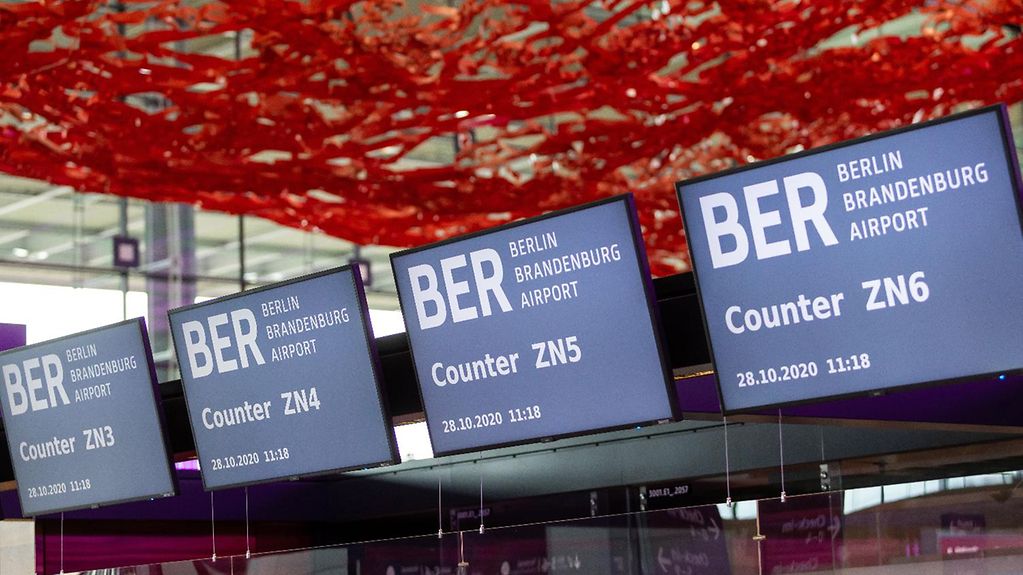Berlin Brandenburg Airport
The waiting is over at last. On 31 October 2020, Berlin Brandenburg Airport Willy Brandt, IATA code BER, opened for business, focussing all air traffic for Berlin and the surrounding area on one site – Schönefeld. Here is a round-up of the main facts.
4 min reading time

Berlin Brandenburg Airport - Check-in desks in Terminal 1
Photo: picture alliance / Andreas Frank
IATA code: Berlin Brandenburg Airport is also named after Willy Brandt. The fact that the airport bears the name of Germany’s fourth Chancellor symbolises Berlin’s emergence as the hub for east-west traffic, linking Europe to the rest of the world. The IATA code for all flights to and from Berlin is BER.
Location: Schönefeld Airport, located in the Brandenburg town of Schönefeld just south of Berlin’s city limits, has been incorporated in the new BER and makes up part of the new airport.
BER opening: Operations are moving to BER in three stages: the opening on 31 October of the airport itself, the opening of the new south runway on 4 November, and the closing of Tegel Airport on 8 November. At each step along the way, airlines are moving their operations to BER.
Delays: After the earth-breaking ceremony in 2006, the opening of BER was delayed several times. Planning errors, construction defects, technical problems and frequent changes in executive staff delayed the project again and again. Over 20,000 defects were identified in the fire detection systems and emergency lighting alone, all of which then had to be rectified. This is why BER is opening for business without any major festivities or celebrations. "There’s no big party. We’re just going to open," said CEO Engelbert Lütke-Daldrup.
Surface area: The existing Schönefeld Airport was expanded by 970 hectares to cover a total surface area of 1,470 hectares. That is equivalent to about 2,000 football pitches.
Runways: Schönefeld Airport’s existing runway was extended from 3,000 to 3,600 metres in length and will constitute the northern runway for BER. The new airport will also have a southern runway, which is 4,000 metres long and 60 metres wide. Because the two parallel runways are 1,900 metres apart, each can be used independently of the other.
Terminals: The new Terminals 1 and 2 are located between the two runways. To the north lies Terminal 5, which is the former Schönefeld Airport. Terminal 1 is the heart of BER, offering 360,000 square metres floor space.
Parking positions: Initially BER offers 85 aircraft parking positions. Another 15 standing slots are currently being built. Another 30 position are available at the northern side of the airport.
Capacity: BER’s three terminals will be able to handle more than 40 million passengers a year, making it Germany’s third largest airport. The capacity is currently sufficient and can be expanded as required.
Costs: According to figures provided by the operator Flughafen Berlin Brandenburg GmbH (FBB), the first construction phase of BER cost about 5.9 billion euros. This was financed by FBB, shareholder funding in the form of equity capital and business loans, as well as bank loans for which guarantees have been given.
Night flight regulation: Regular scheduled flights may not take off or land at BER between midnight and 5 o’clock in the morning. Between 22:00 and 24:00 and between 05:00 and 06:00 the airport is open for flights that are arriving early or have been delayed, as well as handling a certain number of flights stipulated by the authorities.
Noise protection programme: By bringing together all air traffic in one place, more than 100,000 people living in Berlin and Brandenburg will no longer be affected by aircraft noise. People living around BER will be largely protected from aircraft noise by the conditions laid out in the key planning decision, and will benefit from extensive noise protection measures that are unprecedented anywhere in Germany.
Natural environment and landscape: The airport operating company has numerous projects to ensure that the unavoidable changes to the landscape caused by building the airport are offset by other environmental measures. Where flora and fauna habitats were lost, this was offset by creating some 2,000 hectares of habitat elsewhere. Future development measures will also be supervised by environmental experts.
Local public transport links: BER has its own six-track railway station, with three platforms immediately below Terminal 1. The station is served by the S-Bahn (the swift urban railway), the Airport Express, and regional and long-distance trains. Buses offer an alternative connection.
Road connections: BER has its own junction on the A113 motorway, connecting it with Berlin city centre and the Berlin ring road. BER is also connected to the B96a, a four-lane trunk road, which runs parallel to the A113.
Ownership structure: The federal states of Berlin and Brandenburg each own 37 per cent of the operating company, Flughafen Berlin Brandenburg GmbH (FBB), with the remaining 26 per cent held by the Federal Republic of Germany.
You can find our more on the website of BER.